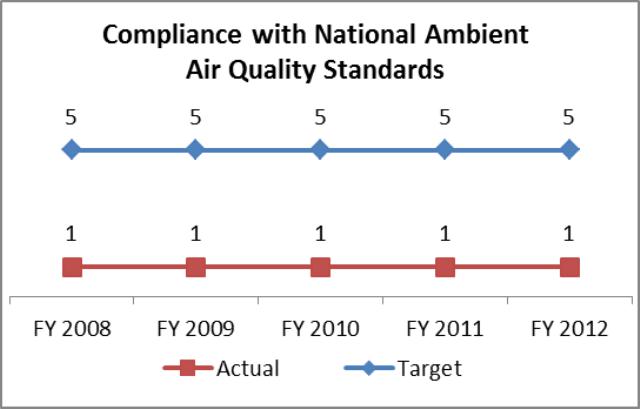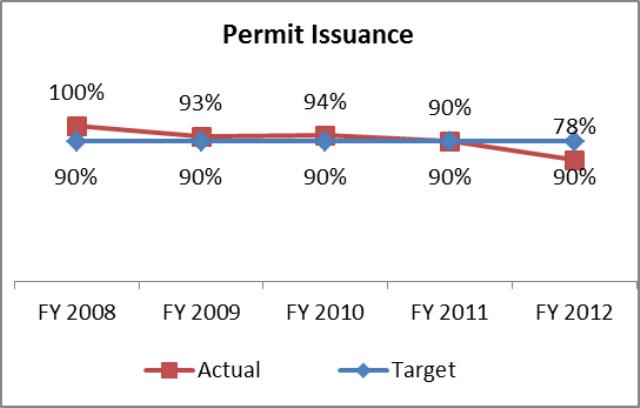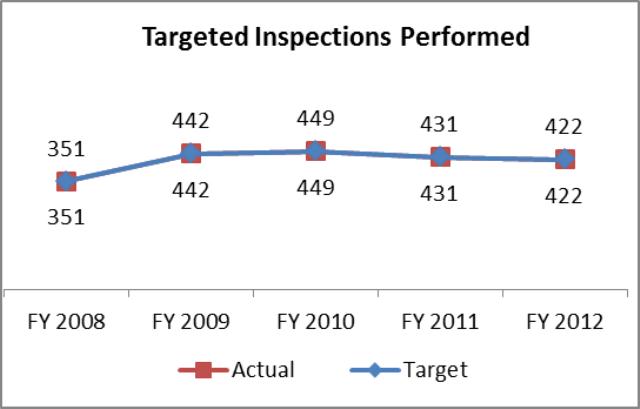Agency: Environmental Quality Line Item: Air Quality Function The mission of the Division of Air Quality is to achieve and maintain levels of air quality that protect public health, property, and vegetation in Utah from the effects of air pollution. In order to accomplish its mission, this division is divided into the following three branches: (1) Compliance Branch, (2) Permitting Branch, and (3) Planning Branch. A brief description of each section within the three branches follows:
Compliance Branch Major Source Compliance Section: This section is responsible for ensuring that the requirements of the Utah Air Conservation Act are met for all major sources. This is done by the inspection and enforcement activities of all major industrial air pollution sources located throughout the state. The division regulates around 100 major sources. Minor Source Compliance Section: This section is responsible for ensuring that the requirements of the Utah Air Conservation Act are met for all minor sources that have been issued an approval order. This is done by the inspection and enforcement activities of all of these sources located throughout the state. The division regulates over 1,800 minor sources through approval orders. Air Toxics, Lead-Based Paint, Asbestos, and Small Business Environmental Assistance Program Section (ATLAS): The ATLAS section's mission is to investigate and ensure compliance with the Utah Air Quality Rules. This is done through site inspections, asbestos and lead-based paint project notification reviews, and technical assistance to the public and the regulated community, and through enforcement actions. Permitting Branch Major and Minor New Source Review Sections: The functions of these sections are mainly related to regulation of the emissions of air contaminants from "stationary sources" (industrial sources). This involves reviewing the design of all new or modified stationary sources to determine that the source will be able to comply with the Utah Administrative Code (UAC) and the Federal Air Quality Regulations. It is accomplished by issuing a construction permit called an Approval Order. To facilitate the workload, the New Source Review program is divided between the Major New Source Review and Minor New Source Review Sections. Operating Permit Section: The Federal Clean Air Act requires a program be developed in all states to issue renewable operating permits to specific large or major air pollution sources and provide special technical assistance. Planning Branch This branch is responsible for the development and maintenance of the State Implementation Plan (SIP) for the control of carbon monoxide, ozone, sulfur oxides, and particulate matter. Air Monitoring Section: This section is responsible for the collection of accurate and precise ambient air data in Utah for use by local, state, and federal agencies. Technical Analysis Section: This section is responsible for a wide variety of tasks, including dispersion modeling, geographic information systems (GIS), and the collection and evaluation of emission inventories. The section also conducts special air quality studies for important state issues such as oil and gas development, Snake Valley aquifer pumping, and quality growth planning. Mobile Sources Section: This section is responsible for issues dealing with emissions from vehicles. The Air Quality Division is responsible to measure air quality as outlined by the federal air quality health standards. Recently, the division monitored violations of the particulate matter due to changes to the National Ambient Air Quality Standard (NAAQS). The division is completing the three year process to develop a new plan to bring the areas within Utah that are violating the NAAQS back into attainment.
Recent air monitoring for ozone in the Uintah Basin has identified concerns with the levels measured during the winter months. The division led efforts to understand the chemistry and processes that result in elevated levels associated with oil and gas producing basins. In June, Duchesne and Uintah counties were accepted into EPA's Ozone Advance program. Work is underway with the counties and producers to proactively identify reasonable strategies to reduce the ozone levels. Monitoring stations were established in Roosevelt and Vernal to provide air quality forecasting and current conditions for public health notifications. The Utah Clean Diesel Program is a clean air initiative that started in 2008. The program is a collaboration between state and federal agencies, county and municipal governments, community and non-profit organizations, and industry groups. Over $5.4 million in state and federal grants have helped 32 small businesses and 30 school districts purchase cleaner and more fuel efficient equipment for their operations. The following Clean Diesel projects have been completed to date: - The Clean Diesel School Bus project retrofitted nearly 1,200 diesel-powered school buses throughout the state with emission control devices that are aimed to protect children and operators from harmful air pollutants emitted by a school bus's diesel engine. This project also replaced 27 older buses with new buses that meet a more stringent set of emissions standards.
- The Clean Diesel Trucking project installed auxiliary power units on 52 long-haul trucks. These units reduce fuel consumption and diesel emissions by providing climate control and electrical power for the truck's sleeper cab and engine block heater during the driver's downtime. These devices use 80-90 percent less fuel than the truck's main engine.
- The Clean Diesel Agriculture project installed auxiliary power units on 32 trucks that support farm-based activities. This project also repowered and replaced 31 pieces of diesel equipment with cleaner, more fuel efficient machinery.
The Utah Clean Diesel program is based on partnerships with a variety of sectors, including education, agriculture, trucking, and construction to provide cleaner and more efficient transportation and equipment alternatives to Utah communities. Performance The number of air sheds in metropolitan statistical areas (MSAs) representing the state's population centers that meet all federal air quality standards annually. St. George, Provo-Oren, Salt Lake, Ogden-Clearfield, and Logan are the targeted MSA air sheds in the state. The EPA revised the standard for PM2.5 in 2006. Utah is developing a plan to bring four air sheds back into compliance by 2019.  UCA code 19-2-108 requires the director of the Division of Air Quality to issue permits with 180 days. However, the Governor's Balanced Scorecard goal was changed from 120 days to 110 days following a process improvement evaluation in 2011.  Routine compliance inspections are targeted based on an annual compliance monitoring strategy (CMS). This measure ensures that scheduled inspections are performed as assigned.  In addition to the key performance measures listed above, the division reported the following performances measures for FY 2012: - operated an ambient air monitoring network, providing pollution information for daily air quality status from 25 air monitoring locations;
- developed State Implementation Plans to bring three areas back into compliance with national ambient air quality standards;
- reviewed and issued air permits for 215 new or modifying sources; and,
- completed 422 compliance inspections of major and minor sources.
Funding Detail For more detail about a particular source of finance or organizational unit, click a linked entry in the left column of the table(s) below. Sources of Finance
(click linked fund name for more info) | 2009
Actual | 2010
Actual | 2011
Actual | 2012
Actual | 2013
Approp | | General Fund | $4,314,600 | $3,671,800 | $3,583,600 | $3,747,500 | $3,750,800 | | General Fund, One-time | $288,000 | ($143,000) | $0 | $0 | $49,500 | | Federal Funds | $2,716,500 | $5,132,200 | $4,354,900 | $4,063,300 | $4,370,300 | | Dedicated Credits Revenue | $5,200,900 | $5,061,600 | $5,126,300 | $4,799,100 | $4,910,900 | | Clean Fuel Conversion Fund | $109,400 | $108,800 | $110,000 | $109,900 | $110,400 | | Transfers - Within Agency | ($791,900) | ($934,700) | ($823,300) | ($918,800) | ($884,500) | | Beginning Nonlapsing | $259,400 | $215,000 | $29,200 | $29,200 | $0 | | Closing Nonlapsing | ($215,000) | ($29,200) | ($29,200) | ($150,000) | $0 | | Lapsing Balance | ($192,100) | ($325,600) | $90,200 | ($57,700) | $0 | | Total | $11,689,800 | $12,756,900 | $12,441,700 | $11,622,500 | $12,307,400 |
|---|
| | | | | | Programs:
(click linked program name to drill-down) | 2009
Actual | 2010
Actual | 2011
Actual | 2012
Actual | 2013
Approp |
|---|
| Air Quality | $11,689,800 | $12,756,900 | $12,441,700 | $11,622,500 | $12,307,400 | | Total | $11,689,800 | $12,756,900 | $12,441,700 | $11,622,500 | $12,307,400 |
|---|
| | | | | | Categories of Expenditure
(mouse-over category name for definition) | 2009
Actual | 2010
Actual | 2011
Actual | 2012
Actual | 2013
Approp |
|---|
| Personnel Services | $8,319,100 | $7,312,800 | $8,508,000 | $7,407,000 | $9,172,500 | | In-state Travel | $21,800 | $18,300 | $23,400 | $32,800 | $24,500 | | Out-of-state Travel | $44,100 | $35,900 | $36,600 | $40,800 | $46,500 | | Current Expense | $1,772,100 | $2,133,600 | $1,895,200 | $1,676,600 | $1,643,900 | | DP Current Expense | $943,200 | $815,600 | $850,100 | $529,100 | $817,700 | | DP Capital Outlay | $5,300 | $0 | $0 | $0 | $372,600 | | Capital Outlay | $548,200 | $314,700 | $751,700 | $455,200 | $0 | | Other Charges/Pass Thru | $36,000 | $2,126,000 | $376,700 | $247,700 | $229,700 | | Cost Accounts | $0 | $0 | $0 | $1,233,300 | $0 | | Total | $11,689,800 | $12,756,900 | $12,441,700 | $11,622,500 | $12,307,400 |
|---|
| | | | | | | Other Indicators | 2009
Actual | 2010
Actual | 2011
Actual | 2012
Actual | 2013
Approp |
|---|
| Budgeted FTE | 98.3 | 98.0 | 98.5 | 98.3 | 96.0 | | Actual FTE | 85.3 | 89.2 | 88.2 | 97.9 | 0.0 | | Vehicles | 10 | 11 | 12 | 12 | 11 |
|
|
|
|
|
|
|---|
Subcommittee Table of Contents |


